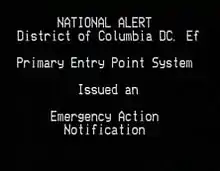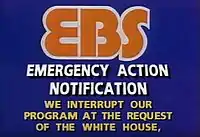Emergency Action Notification
An Emergency Action Notification (SAME code: EAN) is the national activation of the Emergency Alert System (EAS) and is used to alert the residents of the United States of a National or Global emergency such as a nuclear war or any other mass casualty situation. Emergency Action Notifications can only be activated by the President or the President's representative (i.e. the Vice President).[1] The Emergency Broadcast System (EBS) also carried the Emergency Action Notification. No situation since the alert's creation has been serious enough to cause a US President to broadcast it.

.gif)
| Type | Incentive |
|---|---|
| Industry | Emergency |
| Founded | 1984 United States |
| Headquarters | United States |
| Parent | Emergency Alert System |
Operation
EAN messages are treated similarly to other EAS messages. When a message is received, the receiver is to open an audio channel to the originating source until the End of Message (EOM) tones are received. After the EOM is received, the station is then allowed to resume normal programming.[lower-alpha 1][2]
The order of broadcast
On participating stations, the following message would be read:
“We interrupt our programming; this is a (national/global) emergency.”
After the header codes and attention signal are sent, the participating station reads an introductory script. Emergency messages are then read in this order:
- Presidential messages, which "take priority over any other message"
- Local messages
- State messages
- National Information Center messages
A standby script is used in the case of there being no new information available.
The end-of-message codes are transmitted after presidential messages are read. The operator logs the time and date the Emergency Action Notification was received, and monitors their EAS source, awaiting an Emergency Action Termination message.[3]
Background
The term "Emergency Action Notification" was created when the Emergency Broadcast System went into place in 1963. Before the mid-1970s, this was the only non-test activation permitted (the same rule also applied to the earlier CONELRAD system). The EAN signifies of a national emergency, as the wording shows. The Office of Civil Defense originally created the term for the national emergency notification enactment. FEMA soon took over after its creation.
Past operation
Unlike other messages, the EAN was not the alert itself, but rather a notice that the activation is beginning.[5] After the End of Message (EOM) tones were sent, normal programming did not resume. Instead, most stations were to broadcast emergency information in a specific priority order. Messages from the President are always broadcast first. Next comes local messages, statewide and regional messages, and finally national messages not originating from the President.[lower-alpha 2][6] When an EAN was initially received, and during any time a new message was not available, an FCC mandated standby script was used (and repeated).[7] Other stations, which held special permission from the FCC, would sign off until the end of the EAN.[8]
Normal programming would not continue until the transmission of an Emergency Action Termination message (SAME code: EAT).[7]
False alarms
A properly authenticated Emergency Action Notification was incorrectly sent to United States broadcast stations at 9:33 a.m. Eastern Standard Time on February 20, 1971.[9] At the usual time, a weekly EAN test was performed. NORAD teletype operator W.S. Eberhardt had three tapes in front of him: a test tape, and 2 tapes indicating a real emergency, instructing the use of EAN Message #1, and #2, respectively. He inadvertently used the wrong tape, with codeword "HATEFULNESS". This message ordered stations to cease regular programming immediately, and begin an Emergency Action Notification using Message #1.[10][11] Message 1 states that regular programming has been interrupted at the request of the United States government, but is not specific about the cause.[12] A cancellation message was sent at 9:59 a.m. EST, but the message's codeword, "HATEFULNESS" again, was incorrect.[13] A cancellation message with the correct codeword, "IMPISH", was not sent until 10:13 a.m. EST[13] After 40 minutes and six incorrect or improperly formatted cancellation messages, the accidental activation was officially terminated.
On June 26, 2007, an EAN was accidentally activated for the state of Illinois, when new satellite delivery equipment for the EAS was accidentally left connected to a live network during what was meant to be a closed-circuit test.[14][15]
On October 24, 2014, Bobby Bones' syndicated radio program broadcast audio from the 2011 national test of the EAS (the only one that was coded as an EAN), during a segment where he ranted over his local Fox affiliate's scheduling of an EAS test during a World Series game. The broadcast triggered the EAS on some broadcasters and cable systems; the program's distributor iHeartMedia was fined $1 million by the FCC for the incident.[16]
In 2016 or 2017, KUCO-LD in the Sacramento Valley area of California conducted an unauthorized test of the EAS. However, the message read in Spanish said that the activation was for an Emergency Action Notification relaying from station K20FZ. It was due to a wrong video cartridge being inserted instead of an EAS test cartridge.[17]
References
- "FCC Rules Part 11 Subpart D § 11.53". Electronic Code of Federal Regulations. Archived from the original on 9 October 2012. Retrieved 1 September 2011.
- FCC. "Review of the Emergency Alert System A Rule by the Federal Communications Commission on 03/22/2012". Federal Register. Retrieved 1 September 2013.
- "Emergency Alert System - 2007 TV (including Digital TV) Hndbook" (PDF). Retrieved 30 December 2017.
- The Museum of Classic Chicago Television (www.FuzzyMemories.TV) (2017-03-03), WGN Channel 9 - Emergency Broadcast System - "This is NOT a Test" (1985), retrieved 2017-04-26
- "FCC Rules Part 11 Subpart D § 11.13". Electronic Code of Federal Regulations. Archived from the original on 9 October 2012. Retrieved 1 September 2011.
- "FCC Rules Part 11 Subpart D § 11.44". Electronic Code of Federal Regulations. Archived from the original on 9 October 2012. Retrieved 1 September 2011.
- "FCC Rules Part 11 Subpart D § 11.54". Electronic Code of Federal Regulations. Archived from the original on 9 October 2012. Retrieved 1 September 2011.
- "FCC Rules Part 11 Subpart D § 11.41". Electronic Code of Federal Regulations. Archived from the original on 9 October 2012. Retrieved 1 September 2011.
- "Code Word "Hatefulness": The Great EBS Scare of 1971". CONELRAD Adjacent. Retrieved 7 October 2013.
- (Timestamp to WCCO white card script instruction) 2001scoop, W6LDS (2012-09-16), 1971 False Emergency Broadcast System EAN (Heard On WOWO-AM And WCCO-AM), retrieved 2018-05-22
- "EAN Teletype message (February 20, 1971 09:33 EST)". 2014-10-16. Archived from the original on 2014-10-16. Retrieved 2018-05-22.
- "The EBS Authenticator Word List". www.ae5d.com. Retrieved 2018-05-22.
- "The Great Accidental Test Broadcast of 1971". Archived from the original on 21 January 2013. Retrieved 7 October 2013.
- "Emergency Alert System Activated By Mistake". cbs2chicago.com. Archived from the original on August 6, 2008.
- "Inadvertent Activation of the Illinois Emergency Alert System". FEMA. June 28, 2007. Archived from the original on July 17, 2007.
- Brodkin, Jon (2015-05-19). ""Multi-state cascade" of false emergency alerts nets $1 million fine". Ars Technica. Retrieved 2019-05-29.
- Emergency Action Notification Mistake? (AKA: Spanish EAS?) - YouTube (uploaded May 24th, 2017)
Notes
- Unlike other messages EANs do not time out after two minutes
- Some documents refer to these as "messages from the National Information Center (or NIC)". While there is a SAME code for this type of message (NIC), there exists no FCC definition of the National Information Center.
